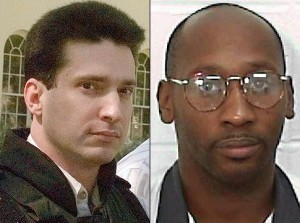The Distribution of Sympathy and the Death Penalty
On September 21, our screens were filled with images and stories of Troy Davis’ execution and the protests against it. The same day, there was another execution in Texas. Russell Brewer, one of the three white men convicted of brutally dragging James Byrd Jr. to death in 1998, was executed just hours before Davis was.
These two men’s stories and executions were in many ways very different. Davis was a black man accused of killing a white man. Brewer was a white man accused of killing a black man. There were doubts about Davis’ guilt: there was no physical evidence, and key witnesses later recanted their stories. There was little doubt about Brewer’s guilt. Despite these differences, the two cases both demonstrate inequalities in the way individuals are able to appear as victims (or perpetrators) within legal procedure and decisions.
In Davis’ case, the lack of physical evidence and the fact that several key witnesses changed their testimony since the trial was, surprisingly, not enough to stay his execution. Quite simply, the justices reviewing the case failed to see him as a potential victim of procedural error or injustice. This failure, in light of very real problems of evidence and testimony suggests one of the key problems of practices of justice: the unequal distribution of sympathy. It would be nice to think that the justices who reviewed the case did so “neutrally” and “objectively,” but the data on death penalty suggests otherwise. Amnesty International reports that 77% of all executions for homicide involve a white victim. In contrast, 15% of executions involve a black victim, and 6 % a Hispanic victim (2% of victims were “other”) in the last 30 years.
One of the factors that explain these statistics and the lack of doubt in Troy Davis’ case is sympathy, or lack thereof. The ability to feel sympathy or not pervades many aspects of judgment. An ability to imagine a defendant or victim as like oneself or one’s family will impact the judgments we make about that person – our ability to see him or her as a victim or a perpetrator. This ability is influenced by, among other things, media representations. Images of victimization, for good or bad, ask for sympathy.
We feel sympathy for those we are close to and can imagine ourselves as close to. For distant others, victimization is a common reason for feeling sympathy. However, the ability to appear a victim is not equally available to all. We have culturally defined ideas of what victims look like that make us more ready to see some people as victims than others (as the intense scrutiny of the dress, manner, and morals of female defendants in rape trials attests). These ideas are embedded in, among other things, race and gender. In particular, news representations provide the public with largely criminal images of black men, in which black men appear as perpetrators much more than as victims. For example, Entman and Rojecki’s study of black and white portrayals of crime in local Chicago news during the late 1990s found that while only 26% of black suspects were given names in the news, 46% of white suspects were identified by name; that while 38% of black suspects were shown in physical custody, only 15% of white suspects were shown in custody; and that stories about black suspects were four times more likely to use mug shots as illustration than were stories about white suspects.
When James Byrd Jr. was murdered by three white men, journalists devoted considerable space to emphasize his status as an innocent victim, as if anything beyond the brutality of the murder were needed to communicate his victimization. When his killers were tried, much was made of the fact that two of them, Brewer and John King, were sentenced to death. They were among the first white men to be sentenced to death for killing an African-American in Texas history. The fact that the two men were highly unsympathetic helped them become part of this statistic. They did not show remorse for the murder, had prior convictions, and were admitted white supremacists with multiple tattoos of white supremacist and Nazi symbols. They were easy to see as purely monstrous, certainly not men that the majority wanted to find commonality with. The third assailant, Shawn Berry, on the other hand, was a much more sympathetic figure. He was not a convict, did not have the sensational tattoos. He did not look and seem like a future threat to society, and so was sentenced to life. In the trail’s coverage, the reasons given for clemency for Berry were not about what he did or did not do that night, but about who he was: a “regular kid.” The point is not that Berry should have gotten a harsher penalty. The point is that the decision to give him a life sentence and the others a death sentence hinged in large part on the sympathy judge and jury felt for him, not on any sure knowledge that he was a lesser participant in the beating and dragging of Byrd. The distribution of sympathy is not equal; this is as true inside the courtroom as outside of it.
The individuals involved in deciding and carrying out capital punishment do not sit outside the influences of sympathy, nor of the influence of media texts in inculcating it. Most of those who comment upon Davis and Brewer have only “met” these men through media texts. These texts do an important job in locating the men in relation to viewers/readers and in dictating their location along the scale of the sympathetic. When we consider how much the distribution of sympathy is shaped by our own social locations and media contexts, it becomes difficult to imagine the death penalty being applied equitably, no matter how fine-tuned the procedures.



